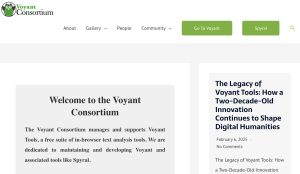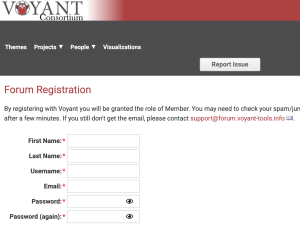Reflection after a panel for CSDH‑SCHN 2025: Reframing Togetherness
Introduction
How can we sustain research tools like Voyant? The funding ecology in Canada is one that rewards new and innovative projects, not the maintenance of existing tools, even when they are widely used as Voyant is. In this collection of interventions we explore the challenge of sustainability and whether a consortium model can sustain a suite of tools like Voyant. These interventions are based on presentations at a panel organized for CSDH‑SCHN 2025 and held at George Brown College May 31st 2025 with the title, “Building a Consortium: An Approach to Sustainability.”
Background
Voyant Tools is a suite of text analysis and visualization tools designed by humanists for the study of literary, historical, and philosophical texts. (Rockwell & Sinclair 2016) It is used by textual scholars and students around the world as the interface has been translated into 14 languages. It is an in‑browser tool suite so users don’t have to install anything locally. Instead, you upload a text (or texts), Voyant indexes the text, and then you are presented with a view of a selection of interactive tools like Cirrus, a word‑cloud tool. There are 24 tools, though some tools like the ScatterPlot tool visualize results of multiple text‑mining methods. Analytics gathered on usage indicate that in 2024 Voyant was used by over 200,000 people from around the world.
Why a Consortium?
With the passing of lead designer/developer Stéfan Sinclair in 2020 it became important to expand the team that sustained Voyant Tools. Sinclair had the skills and love of programming to maintain Voyant in between the grants when other developers could be hired. With Sinclair gone it became clear we needed to build a new “togetherness” that could sustain Voyant over the long term and finish the Spyral notebook programming environment he had started. (Rockwell, Land, and MacDonald 2021; Rockwell 2023)
Origins of the Consortium
The idea for a Consortium emerged in discussions in the early months of 2020 that I (Geoffrey Rockwell) had with Stéfan Sinclair before he passed. We discussed forming an organization that would bring in others, engage in succession planning, and open the management and development of Voyant to its community of users. After Sinclair’s passing I announced the development of the Consortium in the Zampolli lecture on “Sustaining Collaboration with Voyant and Spyral” (2022). I then set about connecting with potential founding members and developing the needed Consortium infrastructure (as opposed to Voyant as infrastructure). This was completed and the official launch was announced at DH 2024. As of writing there are 342 members who have signed up through the Voyant Forum (forum.voyant‑tools.info).
Sustaining Digital Research Tools through a Consortium
Generally speaking, a consortium can be thought of as a bureaucratic technology that can be used to sustain a research project like Voyant. The Text Encoding Initiative, for example, transitioned to a consortium in the late 1990s and early 2000s and is still going strong. (n.a. “History”) Research technology from standards to software tools like Voyant need to be sustained to continue to be useful, especially digital research tools. Unlike a book, which can live on a shelf for years without losing its usefulness, digital research tools are so dependent on a stack of underlying technologies continuing to work, that they frequently start failing within a couple of years. This is one of the reasons digital humanities projects are shifting to minimal computing practices (Risam & Gil 2022) which don’t depend on server-side utilities, but Voyant can’t be delivered as a static site.
In the case of Voyant, the underlying server infrastructure is provided for free by the Digital Research Alliance of Canada (DRAC), but this still needs human attention on a regular basis. We need technical support to update code, to fix bugs found by users, and to add new features. Ideally we would have the programming resources to go beyond small fixes and be able to do major updates every five years or so. We also need ongoing human support to apply for grants, report to funders, train new users, respond to technical questions, and to develop documentation. While this technical, human and management support could be provided by a small cadre of full/part time staff, the costs of such a staff complement put us in a situation of having to continually apply for funding which is yet further work that has its own problems, as most grants are for new and innovative work, not for the maintenance. It is easy to get into a vicious cycle of applying for grants and promising to add new functionality which then just adds to what needs to be maintained.
What Could a Consortium Be and How Could It Help Sustain a tool?
Expanding the community that manages and sustains Voyant is why we are trying to develop a consortium. We hope that a Consortium can bring together the community of people invested in Voyant so that we can support each other in developing and using Voyant. We hope that the Consortium can provide a way for volunteers to contribute. We don’t expect that this will completely replace funded technical staff, but volunteers might be able to lighten the load and contribute in ways beyond what a modestly funded team can.
A consortium is an organization that brings two or more people together for some purpose. The word comes from the Latin for “association” which comes from “consors” or “sharing the same fate”. A consortium is an intentional association, developed for a specific purpose. In the case of the Voyant Consortium the purpose is to manage and develop Voyant and associated tools, documentation and training materials. In our bylaws, the purpose of the Consortium described is to:
-
- Provide strategic direction for Voyant and associated technologies;
-
- Maintain and expand the tool suite, including Voyant Tools, Spyral and associated assets, for the use of digital humanities researchers;
-
- Continue developing Voyant Tools and Spyral to meet changing user needs and to take advantage of new techniques/technologies;
-
- Maintain and extend Voyant/Spyral documentation, outreach, support and training activities that benefit the community;
-
- Identify and support research initiatives and partnerships that take advantage of or study Voyant/Spyral and its use;
-
- Maintain the platforms upon which Voyant/Spyral run and relevant partnerships such as that with the Digital Research Alliance of Canada;
-
- Apply for, raise and manage the funds needed to sustainably support Voyant/Spyral, associated assets, and associated activities/initiatives;
-
- Explore fee‑for‑service models for potential users who need a higher level of support, and as a way to support the Consortium.
Given the work it takes to set up and run a consortium, two questions we have asked ourselves are a) whether it is worth it and b) what services it might provide the membership to make it useful to them? The Consortium is thus a collaborative experiment. Can we support users to support Voyant (and the Consortium)? :contentReference[oaicite:10]{index=10}
How Might a Consortium Provide Ongoing Support?
The key to a Consortium providing ongoing support is providing a pathway for people to become involved. Given the number of users of Voyant we hope there are users that are willing to contribute given the right structures. Contributions could include writing grants that add to Voyant, providing services for others like training, contributing to the coding and testing, and even providing donations. In future essays we hope to talk about different calls for participation and experiments in collegial support. :contentReference[oaicite:11]{index=11}
Key Consortium Resources

Figure 1: Voyant Consortium Home Page – voyant‑tools.info

Figure 2: Voyant Forum Registration Page – forum.voyant‑tools.info
Forum & Newsletter
We also have a forum where people can join which we can build out to allow people and projects to discover each other. And we have a newsletter to keep people abreast of key developments. The newsletter is basically a summary of recent blog posts on the Consortium site.
How might a Consortium provide ongoing support?
The key to a Consortium providing ongoing support is providing a pathway for people to become involved. Given the number of users of Voyant we hope there are users that are willing to contribute given the right structures. Contributions could include writing grants that add to Voyant, providing services for others like training, contributing to the coding and testing, and even providing donations. In future essays we hope to talk about different calls for participation and experiments in collegial support.
References
-
- n.a. (n.d.) “History.” Web page of the Text Encoding Initiative. <https://tei-c.org/about/history/> (2025-06-02)
-
- Risam, R. and A. Gil (2022). “Introduction: The Questions of Minimal Computing.” Digital Humanities Quarterly. 16(2).
-
- Rockwell, G. and S. Sinclair. (2016) Hermeneutica: Computer-Assisted Interpretation in the Humanities. Cambridge, MA: MIT Press.
-
- Rockwell, G., Land, K., and A. MacDonald. (2021) “Social Analytics Through Spyral.” Pop! Public. Open. Participatory. No. 3 (2021-10-31).
-
- Rockwell, G. (2022) “Sustaining Collaboration with Voyant and Spyral.” Antonio Zampolli Prize lecture delivered online at Digital Humanities 2022 organized by the University of Tokyo.
-
- Rockwell, G. (2023) “If Voyant then Spyral: Remembering Stéfan Sinclair.” In On Making in the Digital Humanities. Eds. Nyhan, J., Rockwell, G., Sinclair S. and A. Ortolja-Baird. London, UK: UCL Press.
-
- Sinclair, S. & G. Rockwell. (2013) “Voyant Notebooks: Literate Programming and Programming Literacy.” Poster presented at the Digital Humanities 2013, University of Nebraska-Lincoln.
